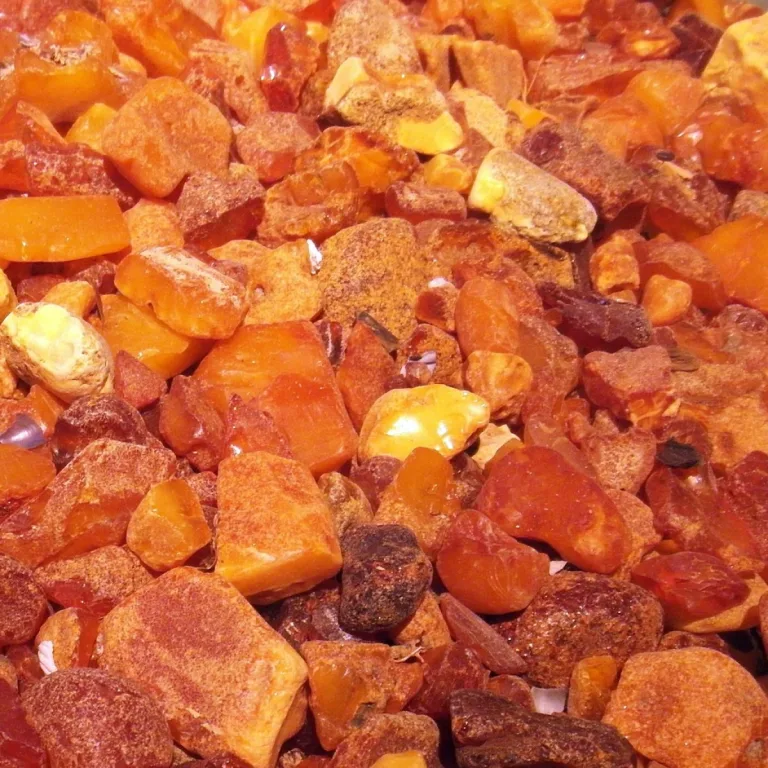Free radicals are also known as ROS – reactive oxygen species. These are chemical compounds formed by oxidation, for example, as by-products of metabolism.
Free radicals are unsteady molecules that the body produces as a reaction to environmental and other pressures, as the body processes food and reacts to the environment. Therefore, it is totally normal to have some free radicals in your body.
Occasionally, however, the proportion of free radicals in the body may increase significantly and, due to their high activity, will instead begin to attack the body’s own cells, damaging the cells. The damaged cells, in turn, produce new free radicals.
In conclusion, if the body cannot process and remove free radicals efficiently, oxidative stress can result, and this can harm cells and body functions that lead to an overall aging of the body.
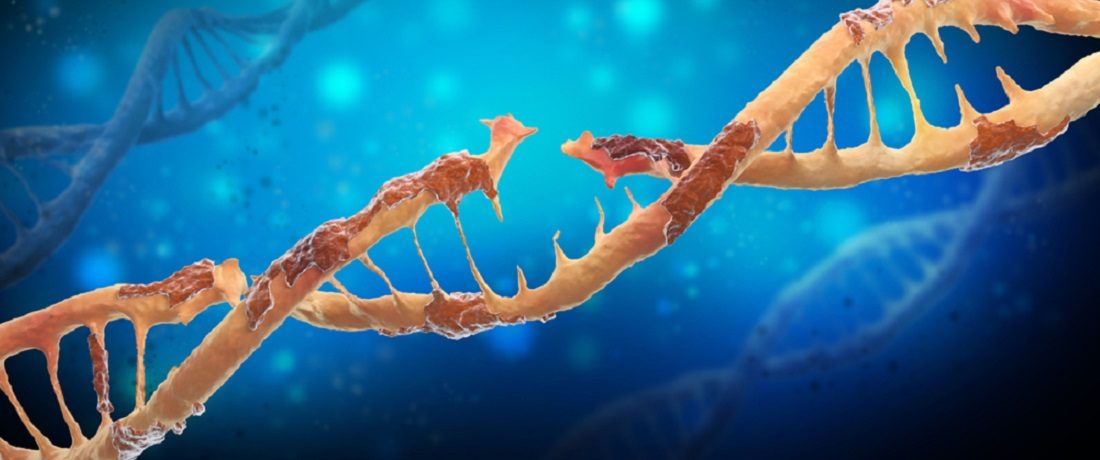
Free Radicals
Free radicals are normal side-effects of progressing biochemical responses in the body, including immune system reactions and common metabolic procedures.
These are exceptionally unsteady atoms that have electrons accessible to respond with different natural substrates, for example DNA, proteins and lipids. Free radicals include:
- Hydroxyl (OH•)
- Superoxide (O2•–)
- Nitric oxide (NO•)
- Nitrogen dioxide (NO2•)
- Neroxyl (ROO•)
- Lipid peroxyl (LOO•)
- Also, hydrogen peroxide (H2O2), ozone (O3), singlet oxygen (1O2), hypochlorous acid (HOCl), nitrous acid (HNO2), peroxynitrite (ONOO–), dinitrogen trioxide (N2O3), lipid peroxide (LOOH), which are not free radicals and generally called oxidants, but can easily lead to free radical reactions in living organisms.
Substances that can promote free radicals may be found in the food we eat, the drugs and medicines we take, the water we drink, and in the air we breathe.
Free radicals can cause destruction to parts of cells (cell membranes, proteins and DNA) when stealing their electrons. The stealing process is called oxidation. Therefore, the damage caused by free radicals is also called “oxidative damage” or “oxidative stress“.
At the point when free radicals steal significant parts of the cell, those parts lose their capacity to work properly, and the build-up of such harm may result in cell death. In conclusion, increased activity of free radicals causes or quickens cell injury and prompts sicknesses.
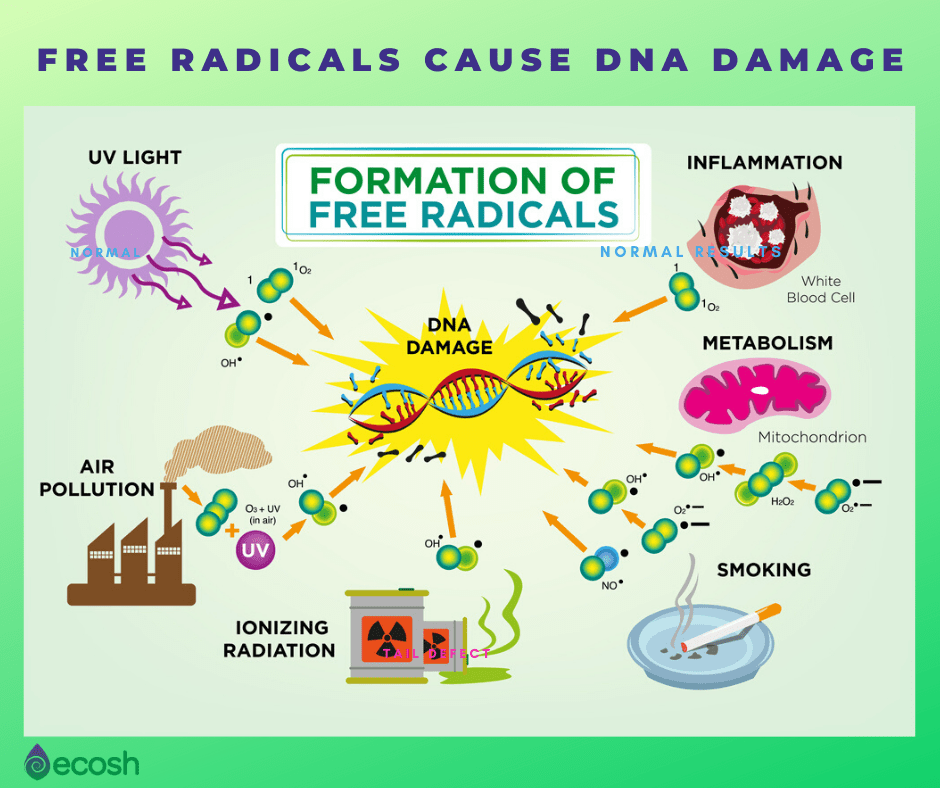
The Causes of a Dangerous Increase of Free Radicals
The increase of free radicals can be dangerous, but antioxidants can protect against the cell damage that free radicals cause, known as oxidative stress.
However, the antioxidant defense system can be weak because of disease, aging, low levels of antioxidants in food, and poor intake. Factors that increase the production of free radicals in the body can be internal, or external.
Internal causes of the high free radical level in the body that can lead to cell damage and oxidative stress include:
- Mitochondrial activity
- Inflammation
- Tissue trauma, due to inflammation and injury
- Ischemia and reperfusion damage
- Stress
- Infectious and chronic diseases
- High internal toxin level
- Age
- Obesity
External causes of the high free radical level in the body that can lead to cell damage and oxidative stress include:
- Consumption of certain foods, especially fried, refined and processed foods, trans fats, artificial sweeteners, food containing carcinogens, and certain dyes and additives
- Excessive exercise
- Smoking
- UV exposure, and cigarette smoke
- Environmental toxins and pollution
- Radiation
- Exposure to chemicals, such as pesticides and drugs, including chemotherapy, and the consumption of skincare products that contain high amounts of parabens and other chemicals
- Industrial solvents
- Alcohol
- Some medications
- Low levels of antioxidants in food
In conclusion, all these internal and external causes of the increased free radical level can result in cell damage and oxidative stress. However, an intake of antioxidants is believed to reduce this risks.
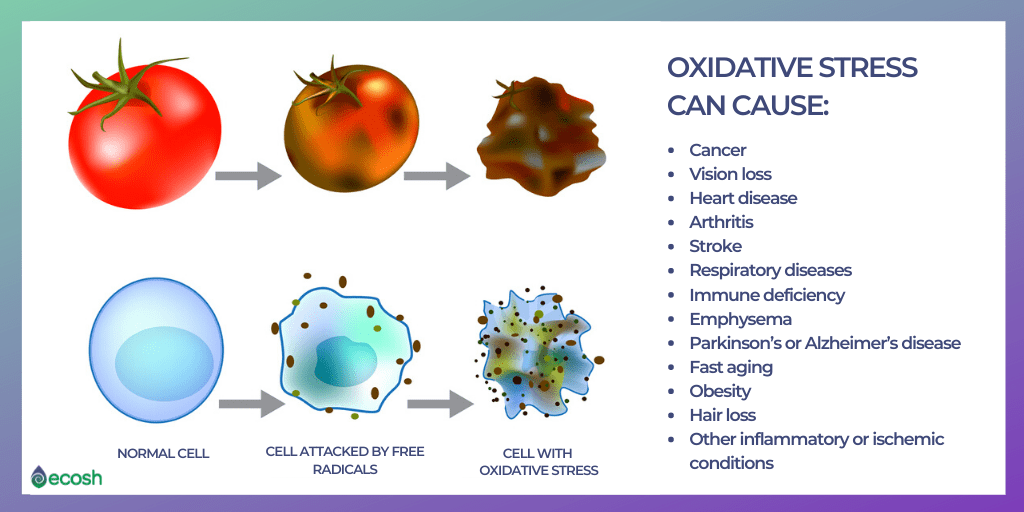
Health Conditions Caused by Free Radicals and Oxidative Stress
In large quantities, free radicals damage DNA, accelerate aging, and contribute to the development of a variety of diseases.
As a result of cell mutation and death – connective tissue in the muscles, bones, cartilages, skin, and blood vessels will be damaged. In conclusion, this leads to aging skin, joint diseases, cataract, atherosclerosis, premature aging, and many more diseases.
Oxidative stress and the damage of free radicals has been linked to:
- Cancer – certain cancers are triggered by damaged cell DNA.
- Atherosclerosis.
- Vision loss – deterioration of the eye lens, which contributes to blindness.
- Heart disease – increased risk of coronary heart disease, since free radicals encourage low-density lipoprotein (LDL) cholesterol to stick to artery walls.
- Arthritis – inflammation of the joints.
- Stroke.
- Respiratory diseases.
- Immune deficiency.
- Emphysema.
- Parkinson’s disease – damage to nerve cells in the brain, which contributes to this condition.
- Alzheimer’s disease – also damage to nerve cells in the brain.
- Obesity.
- Hair loss.
- Fast aging – acceleration of the ageing process.
- An excessive release of free iron or copper ions.
- A disruption of electron transport chains.
- An increase in enzymes that generate free radicals.
- Inflammatory joint disease.
- Asthma.
- Diabetes.
- Senile dementia.
- In addition, other inflammatory or ischemic conditions.
It is thought that the free radicals cause changes in the cells that lead to these and possibly also other conditions. However, antioxidants help to neutralize free radicals in our bodies, which also boosts our overall health.
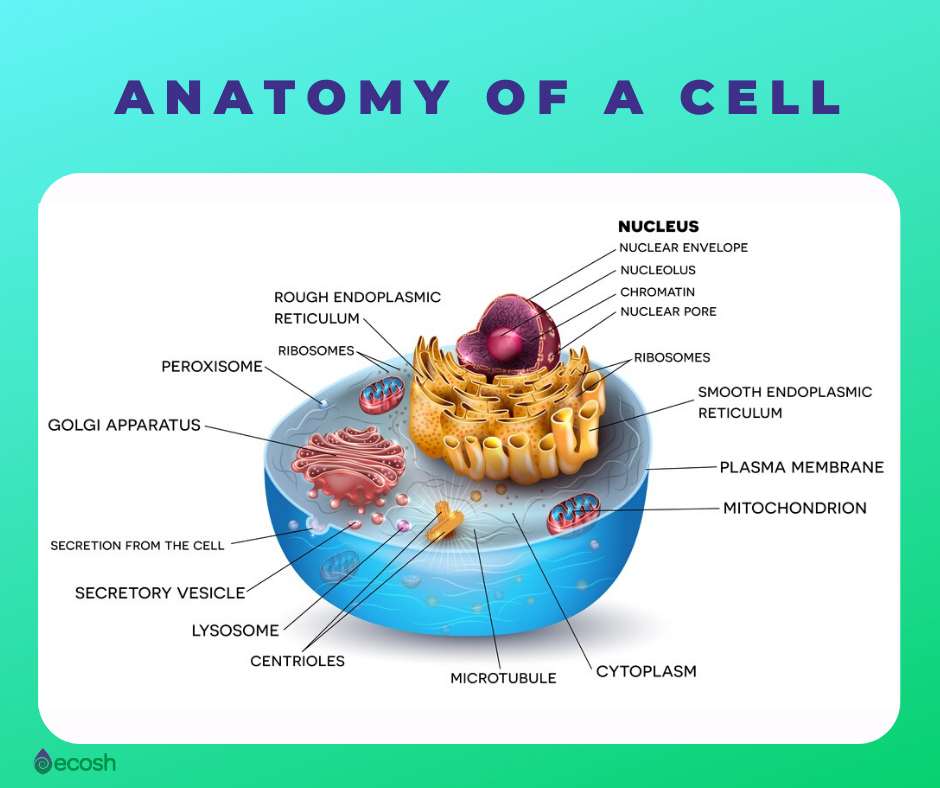
Antioxidants Help Against Free Radicals and Oxidative Stress
The good news is, that antioxidants are the defence mechanism against free radicals. Antioxidants are substances that inhibit and regulate the formation of free radicals, and prevent or slow down the damage to cells caused by free radicals.
So, because of that antioxidants are sometimes also called “free-radical scavengers.”
The sources of antioxidants can be natural or artificial. However, your body also produces some antioxidants, known as endogenous antioxidants.
Above all, each antioxidant serves a different function and is not interchangeable with another. Therefore it is vital to have a diversified diet.
Antioxidant Rich Foods and Food Supplements
Foods and substances that have antioxidant properties that come from outside the body (exogenous) include:
- Vitamins such as Vitamin A, C, E, Q, N (alpha-lipoic acid), P (bioflavonoids), B1, B3, B6, B9:
- A – liver, sweet potatoes, carrots, milk, and egg yolks
- C – oranges, blackcurrants, kiwifruit, mangoes, broccoli, spinach, capsicum and strawberries
- E – vegetable oils (such as wheatgerm oil), avocados, nuts, seeds and whole grains
- B Group Vitamins – include meat (especially liver), seafood, poultry, eggs, dairy products, legumes, leafy greens, seeds and fortified foods, such as breakfast cereal and nutritional yeast.
- Minerals such as selenium (Se), zinc (Zn), manganese (Mn), and copper (Cu):
- Selenium – seafood, offal, lean meat and whole grains
- Zinc – seafood, lean meat, milk and nuts
- Manganese – seafood, lean meat, milk and nuts
- Copper – seafood, lean meat, milk and nuts
- Beta-carotene (β-Carotene) – pumpkin, mangoes, apricots, carrots, spinach and parsley
- Amino acids such as glutamine, histidine, methionine
- Hormones such as melatonin, estradiol
- Glutathione – turmeric
- Carotenoids and Bioflavonoids – These are phytonutrients containing in plant food, that give fruits and vegetables color and flavor
- Flavonoids, Flavones, Catechins, Polyphenols, and Phytoestrogens are all types of antioxidants and phytonutrients found also in plant-based foods.
- Lycopene
- Lutein – green, leafy vegetables like spinach, and corn
- Zeaxanthin
- Flavonoids – tea, green tea, citrus fruits, red wine, onion and apples
- Allium sulphur compounds – leeks, onions and garlic
- Anthocyanins – eggplant, grapes and berries
- Catechins – red wine and tea
- Cryptoxanthins – red capsicum, pumpkin and mangoes
- Indoles – cruciferous vegetables such as broccoli, cabbage and cauliflower
- Isoflavonoids – soybeans, tofu, lentils, peas and milk
- Lignans – sesame seeds, bran, whole grains and vegetables
- Lycopene – tomatoes, pink grapefruit and watermelon
- Polyphenols – thyme and oregano
- Zoochemicals – red meat, offal and fish. Also derived from the plants that animals eat.

7 antioxidant rich food supplements to fight against free radicals
1. Vitamin C
Facilitates the recognition of foreign bodies, damaged cells and autoantibodies in the body, and is necessary for the normal function of enzymes and hormones.
2. Vitamin E
Protects the body from the effects of free radicals that damage cells and accelerate the aging process. In addition, vitamin E is an immune system supporter that helps your body fight infections, and increase the activity of Vitamin A in the body.
3. Vitamin A
A well-known immune booster that helps your body fight viral infections, plays an important role in healing the skin and wounds. In addition, vitamin A is also important for the eyes, and is used to treat severe acne. Vitamin A neutralizes free radicals – these substances that destroy collagen (a substance that is essential for skin elasticity) play a role in inflammatory diseases such as psoriasis.
Multivitamin tablets usually contain at least 800 mcg of vitamin A, and up to 3000 mcg of vitamin A. This is considered safe dose per day, but since vitamin A is stored in the body, you do not need to take it daily. Retinol accumulates in the liver and is toxic in large amounts. Your body needs Zinc to utilize vitamin A stored in the liver. However, pregnant women and women planning to become pregnant should not take vitamin A in the form of retinol.
4. Selenium
Increases lymphocyte count, enhances interferon (immune response) production, and causes B lymphocytes to produce more antibodies.
5. Zinc
Reduces susceptibility infectious diseases, prevents the growth of pathogenic viruses (eg herpes) in the body, and in addition facilitates the immune system. Above all, the absence of zinc can lead to impaired monocyte function, reduced T lymphocyte activity, and impaired antibody production. However, zinc deficiency occurs when overconsuming vegetarian foods (eg cereals and beans inhibit zinc uptake).
6. Curcumin
95% extract of curcumin and piperine with a turmeric BCM-95 extract provides higher efficiency in supporting the normal activity of the heart, respiratory system, gastrointestinal tract and joints. Above all, the extract defends cells from the damage of free radicals, supporting the resistance of immune system (against microbes, parasites and mushrooms). Curcumin also assists mental health and reduces fatigue and exhaustion.
7. Dandelion Root Extract
Dandelion is richer in nutrients than any vegetable. For example, it contains various acids, sugars (e.g. inulin), minerals that your body needs, such as iron, zinc, boron, calcium, silicon, especially potassium, and vitamins A, B, C, and D.
Antioxidant Benefits
Above all, antioxidants stimulate, and significantly increase the body defenses against pathogens and boost the immune system. In conclusion, They help to eliminate harmful toxic substances, inhibit and prevent the onset and development of many dangerous diseases, and contribute to the treatment of almost all chronic diseases.
Antioxidants:
- Slow aging processes
- Lower cholesterol
- Decrease risk of atherosclerosis
- Reduce risk of heart disease and stroke
- Slow Alzheimer’s disease
- In addition, decrease the chance of developing tumors
- In conclusion, reduce the damage caused by cigarette smoke, etc.
Compiled and edited by Maria-Helena Loik
Sources: L and V. Mihkelsoo Self-healer Handbook, Tallinn University Study Material, Betterhealth.vic.gov.au, Medicalnewstoday.com, Ncbi.nlm.nih.gov, Hopes.stanford.edu, Ncbi.nlm.nih.gov
Pictures: Pexels.com, Pixabay.com, Shutterstock.com


